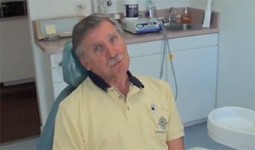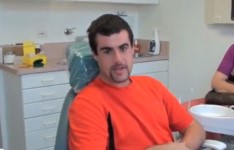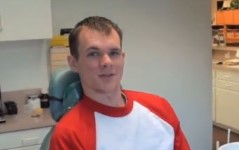What are Movement Disorders
There are several diseases and disorders that have been linked to problems with TMJ. The following list provides a look into these diseases and shows the connection between TMJ/TMD with specific facets of the neurologic and movement disorders.
Parkinson's Disease
Parkinson’s Disease (PD) is a progressive neurological disorder that affects movement. Its symptoms may include tremors, rigidity, and blank faces. Slowing or jerky movements are also characteristic of this disease. Comorbidities of Parkinson’s include difficulty sleeping, forward head posture, problems with balance, and other neurologic problems. Symptoms of the disease usually begin between 50 and 60 years old, although some have experienced earlier symptom onset (WebMD, 2010). Various diagnostic tests are used to determine PD, although there are many disorders that resemble Parkinson’s symptoms.
Genetic and environmental factors play a role in the presentation of the disease in one individual versus another (PDF, 2012). A family history of Parkinson’s, in some cases, increases the susceptibility of a younger person developing the disease (A.D.A.M. Medical Encyclopedia, 2011). PD is believed to be the result of a neurochemical (dopamine) deficiency that affects muscle movement and control. A decrease in dopamine supply essentially disrupts the message relay system of the brain, leading to muscle function loss (A.D.A.M. Medical Encyclopedia, 2011). As PD is a progressive disease, damage to the body becomes worse over time.
Despite this neurochemical explanation for Parkinson’s, the cause of PD is still relatively unknown. New research is bringing to light a “trigeminal disturbance hypothesis” for PD, stating that problems in the trigeminal system, which affects motor movement, may be responsible for the symptoms seen in Parkinson’s (Jennings, 2011). In applying this to tremors, a major symptom of PD, the signal being relayed to the reticular formation (nerves that, when stimulated, cause the head and neck muscles to turn toward the same side as the stimulation) is altered by the disturbances in the trigeminal nerve (Jennings, 2011; Sims & Demerjian, 2012).
Treatment for PD include medication that decreases the specific problem symptoms associated with the disease, deep brain stimulation (DBS) surgery that mainly treats the disabling tremors some patients experience with PD (PDF, 2012), and, under the trigeminal disturbance hypothesis, bite therapy (Jennings, 2011). Treatment of Parkinson’s symptoms, such as tremors or balance problems, using an oral orthotic has shown to be effective in specific case studies of PD. Disturbances in the trigeminal nerve have the potential to alter normal functions of the cerebellum (which is involved in maintaining balance and posture) and can induce the balance and motor symptoms found in the disease (Sims & Demerjian, 2012). When these disturbances are corrected using an oral orthotic, it can lead to improvement of balance and gait as well as decrease or elimination of tremors, correction of head posture or position, and release of neck tension (Demerjian, Sims, & Stack, 2011).
References:
A.D.A.M. Medical Encyclopedia, 2011. Parkinson’s disease. National Center for Biotechnology Information. Retrieved on September 14, 2012 at http://www.ncbi.nlm.nih.gov/pubmedhealth/PMH0001762/ Demerjian, G., Sims, A., & Stack, B. (2011). Proteomic signature of Temporomandibular Joint Disorders (TMD): Toward diagnostically predictive biomarkers. Bioinformation, (5)7, 282-284. Jennings, D., 2011. Trigeminal disturbance hypothesis of Parkison’s. Retrieved on September 6, 2012 at http://parkinsonstmj.com/trigeminal-disturbance-hypothesis-of-parkinsons/Dystonia

Cervical Dystonia (CD), or Spasmodic Torticollis, is characterized by abnormal movement or positioning of the head and neck muscles. These sustained muscle contractions result in abnormal head postures which vary depending on the muscles that are affected. CD is the most common form of focal dystonia (it affects one area of the body) and is found in twice as many women as men (Sims, Stack, & Demerjian, 2012). Symptoms of CD include rotational twisting (laterocollis), backward rotation (retrocollis), or frontal rotation (anterocollis), of the head / neck and/or a combination of these. Pain or head tremor is often associated with those that have sustained contractions and there is often associated dystonia in the upper muscles of the same side (segmental dystonia) (Sims & Demerjian, 2012).
Symptoms of cervical dystonia can present itself between childhood and old age, but its underlying cause has yet to be conclusively determined. Research studies have suggested links between trauma or overuse of the affected area and focal dystonia; however, it does not sufficiently explain the development of the disorder in most patients. Some researchers also argue that there is a genetic component to dystonia that is prompted by trauma, which then triggers the onset of the disorder (Sims et al., 2012).
Current treatments for CD include botulinum toxin (Botox) injections to various muscles affected by the disorder, denervation neck surgery, which cuts the nerves to the muscles and allows for possible corrections of the torticollis, and deep brain stimulation surgery (DBS), which implants electrodes into the brain to control the movement disorder. Botox injections require multiple applications and it is often the case that the body becomes immune to the toxin and loses efficiency. Denervation neck surgery is irreversible and may develop complications, such as numbness in the back of the head or difficulty swallowing, that outweigh its benefits. DBS is used for general dystonias and for those who do not respond to other treatments; however it is only 50% effective and is also irreversible. It requires a secondary surgery to implant a neurostimulator and its effectiveness varies from patient to patient with continued medication intake after surgery. An alternative treatment option is the use of an oral orthotic that increases the vertical dimension and decrease the neuropathy within the temporomandibular joint (TMJ) (Sims et al., 2012).
Research studies have shown that motor activity in specific muscles of the neck is present when the TMJ is stimulated. This stimulus travels to an area of the brainstem called the reticular formation which are nerves that, when stimulated, cause the head and neck muscles to turn toward the same side as the stimulation (Demerjian, Sims, & Stack, 2011). It may be the case that cervical dystonia is a result of chronic activation of the reticular formation due to overstimulation of the nerves within the TMJ (Sims & Demerjian, 2012). When the stimulus is relieved in the TMJ, the stimulus in the reticular formation is also relieved, which then relieves the turning of the head to that side (Sims & Stack, 2009). When the compression is relieved by an oral orthotic, there is a gradual reduction of CD, and the muscles of the head and neck begin to return to normal with a decrease in pain (Sims et al., 2012).
Fibromyalgia
Fibromyalgia is a chronic disorder characterized by pain and tenderness in the joints and muscles of the entire body. It is accompanied by fatigue, loss of sleep, headaches, and has also been linked to depression and anxiety (A.D.A.M. Medical Encyclopedia, 2012). Fibromyalgia is believed to be the result of amplified pain sensations that affect the way the brain processes pain signals (Mayo Clinic, 2011), although it has also been attributed to physical or emotional stress, repetitive injuries, or illness (NIAMS, 2011). Symptoms of fibromyalgia mainly involve pain. Tender points, or painful areas, can be found in the soft tissue of the neck, shoulders, back, hips, elbows, and knees. From these areas, the pain surges to different parts of the body and may feel like a deep ache or a shooting “burning” pain (A.D.A.M. Medical Encyclopedia, 2012). Fibromyalgia affects more women than men, most commonly occurring around middle-age (NIAMS, 2011). It is also more likely to develop in those who have a family member with the disorder and those that have a rheumatic disease (Mayo Clinic, 2011).
Tourette Syndrome

Tourette Syndrome (TS) is a neurological disorder characterized by involuntary movements (tics) and vocalizations. Tics occur frequently and rapidly and can present itself on the face, specific body parts, or the entire body. These uncontrollable motor movements may start as an eye blink or a nose twitch, but can progress to more complicated movements such as kicking or stamping (nTSA, 2012). Verbal tics, such as groaning or throat clearing, usually accompany these involuntary movements. Echolalia, or the spontaneous utterance of sounds, is a well-documented symptom of TS (Sims & Demerjian, 2012), although corpolalia, or involuntary swearing, which is popularly associated with the disorder, is a rare occurrence (nTSA, 2012). Symptoms of TS include either simple or complex tics and often get worse with intense emotions, excitement, or anxiety (NINDS, 2012).
TS can first present itself between 3 to 9 years of age and affect males about 3 to 4 times more often than women (NINDS, 2012). Attention Deficit Hyperactivity Disorder (ADHD), Obsessive Compulsive Disorder (OCD), and other learning disabilities are also found to be associated with Tourette Syndrome (nTSA, 2012). Researchers suggest that there is a genetic component of TS, but no definitive cause of the disorder has been found. Treatments for Tourette Syndrome include medication (e.g., neuroleptics) that helps control symptoms that interfere with daily life; however, as with all medication, side effects do occur (NINDS, 2012). Behavioral treatments such as Cognitive Behavioral Intervention for Tics or supportive therapy have also shown some promise to help people with TS cope with the disorder (NINDS, 2012).
Other treatments for Tourette Syndrome are currently being studied and developed. Some research is focusing on the movement dysfunction involved in TS, using their neurological basis to uncover the relationship between the disorder and problems associated with specific cranial nerves and the motor neurons that they affect (Sims & Stack, 2009). For example, shoulder shrugging is a documented clinical sign of TS. A vast neuronal network affects the voluntary and involuntary movement of the shoulder muscles, and when it is stimulated by a specific cranial nerve (trigeminal), the shoulder shrugging occurs (Sims & Demerjian, 2012). Accordingly, the trigeminal nerve has been implicated in motor dysfunctions and is thought to affect the temporomandibular joint (Demerjian, Sims, & Stack, 2011). This relationship, then, becomes the premise for an alternative treatment for motor disorders, such as TS. By repositioning the teeth and lower jaw to augment the compression of the auriculotemporal nerve endings in the TMJ, stimulation of the nerves that affect shoulder movements cease, and the shoulder shrugging tic diminishes (Sims & Demerjian, 2012). Similar relationships between specific cranial nerves and the nerves that are connected to the TMJ produce similar results, namely a decrease in the urge to produce tics (Sims & Stack, 2009).
References:
Demerjian, G., Sims, A., & Stack, B. (2011). Proteomic signature of Temporomandibular Joint Disorders (TMD): Toward diagnostically predictive biomarkers. Bioinformation, (5)7, 282-284.
National Tourette Syndrome Association (nTSA), 2012. Facts about Tourette syndrome. [PDF]. National Tourette Syndrome Association. Retrieved on September 14, 2012 at http://tsa-usa.org/imaganw/Fact_Sheet.pdf
National Tourette Syndrome Assocation (nTSA), 2012. What is Tourette syndrome. National Tourette Syndrome Association. Retrieved on September 14, 2012 at http://tsa-usa.org/aMedical/whatists.html
NINDS, 2012. Tourette syndrome fact sheet. National Institude of Neurological Disorders and Stroke. Retrieved on September 14, 2012 at http://www.ninds.nih.gov/disorders/tourette/detail_tourette.htm#201653231
Sims, A. & Stack, B. (2009). Tourette’s syndrome: A pilot study for the discontinuance of a movement disorder. The Journal of Craniomandibular Practice, 27 (1), 11-18. Retrieved on September 14, 2012 at http://www.tmjstack.com/casereport.pdf
CRPS/RSD

Complex Regional Pain Syndrome (CRPS), also known as Reflex Sympathetic Dystrophy (RSD), is a nerve disorder that produces chronic pain in an area of the body and is believed to occur as a result of injury or dysfunction to the nervous system (NINDS, 2012). Common features of CRPS include severe skin discoloration and temperature changes over the affected body part, followed by an intense burning sensation, sensitivity to touch, and swelling (NINDS, 2012). CRPS has two forms: CRPS I occurs as a result of a minor injury and CRPS II occurs due to injury to a nerve (A.D.A.M. Medical Encyclopedia, 2012). CRPS affects both men and women of any age, although many experts agree that it is more common among young women (NINDS, 2012).


